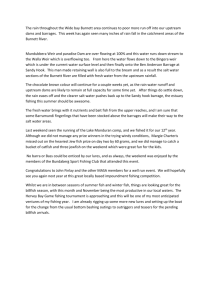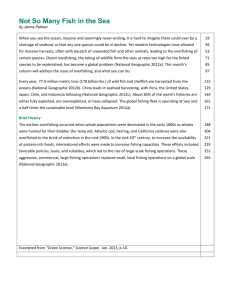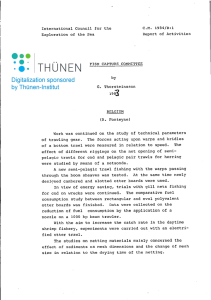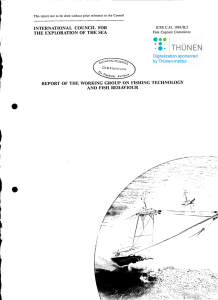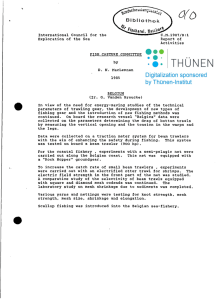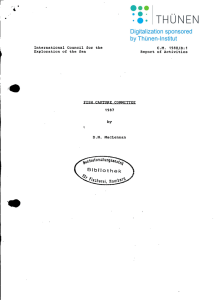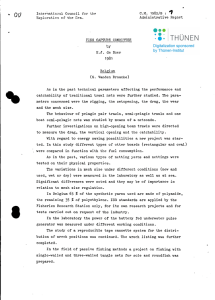Overfishing - an introduction
advertisement
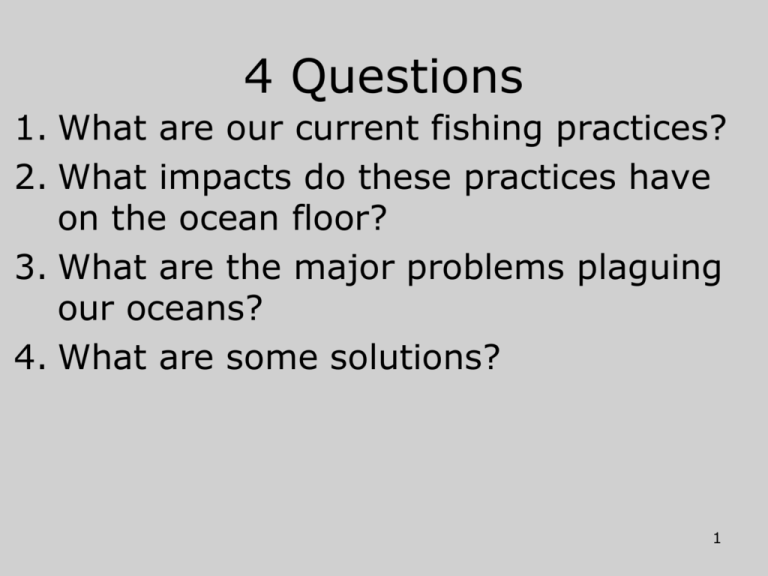
4 Questions 1. What are our current fishing practices? 2. What impacts do these practices have on the ocean floor? 3. What are the major problems plaguing our oceans? 4. What are some solutions? 1 What are the current fishing practices? 2 Fish farming in cage Trawl flap Trawler fishing Spotter airplane Sonar Purse-seine fishing Trawl lines Trawl bag Long line fishing Fish school Drift-net fishing Float Buoy Lines with hooks Deep sea aquaculture cage Fish caught by gills Fig. 12-A, p. 255 Purse Seines Fish farming in cage Trawl flap Trawler fishing Spotter airplane Sonar Purse-seine fishing Trawl lines Trawl bag Long line fishing Fish school Drift-net fishing Float Buoy Lines with hooks Deep sea aquaculture cage Fish caught by gills Fig. 12-A, p. 255 What impacts do these have on ocean life? • Area of ocean before and after a trawler net, acting like a giant plow, scraped it. Figure 12-2 What are the current problems in our oceans? • The major decline in the worldwide catch of fish since 1990 is because of over-fishing. • By-catch- fish or animals that were not meant to be caught. • Pollution in the 5 major gyres ( Trash patches) • Whaling pollution Overfishing and Extinction: Gone Fishing, Fish Gone • About 75% of the world’s commercially valuable marine fish species are over fished or fished near their sustainable limits. – Big fish are becoming scarce. – Smaller fish are next. – We throw away 40% of the fish we catch. – We needlessly kill sea mammals and birds. 10 11 12 13 14 15 BYCATCH • Overfishing and BYCATCH • Sea Turtles 16 Whaling • IWC: International Whaling Commission – Set up in 1946 – 1986 Zero whale catch was introduced (except for subsistence fishermen which have limited numbers) • JAPAN Whaling : RESEARCH – “North Pacific (2) - JARPN II (2000 and ongoing) It included sub-projects on: 1) feeding ecology (including prey consumption and preferences of cetaceans and ecosystem modeling); 2) stock structure; 3) environmental effects on cetaceans and the marine ecosystem http://www.bbc.com/news/world-asia-17312460 http://www.takepart.com/article/2013/03/01/japan-retreats-whale-hunt • WHALE WARS 17 Sustainable Fishing Practices 19 20 How do we do this… • Market Place – Read labels • Economic Incentives – – – – – TEDs Round hooks No more subsidies Optimum sustainable yield Individual Transferable Quotas (ITQ’s) – – – – IWC Japan Whaling Research Exclusive Economic Zones vs. high seas Marine Protected Areas (MPA’s) • Regulatory Approaches Aquacultures aka Blue Revolution Advantages • Possibly support 50% of world’s seafood need. • Low fuel cost • High yield in low volume of water • Reduces overharvesting Disadvantages • Large waste output • Destroy habitats • Uses grain to feed some species • Dense populations susceptible to disease. • Escapes threatens wild fish populations (Disease, competition and interbreeding) • Aquaculture: http://www.nmfs.noaa.gov/aquaculture /library/aq_video_gallery.html • Sustainable fishing in the Coral Triangle:http://wwf.panda.org/what_w e_do/how_we_work/conservation/mari ne/sustainable_fishing/ • TED’s:http://video.nationalgeographic.c om/video/environment/threats-toanimals-environment/turtle-excluder/ Now its time to summarize… These notes are about… Three things I learned today are… 24




